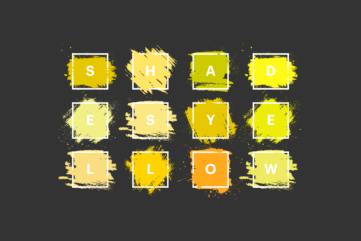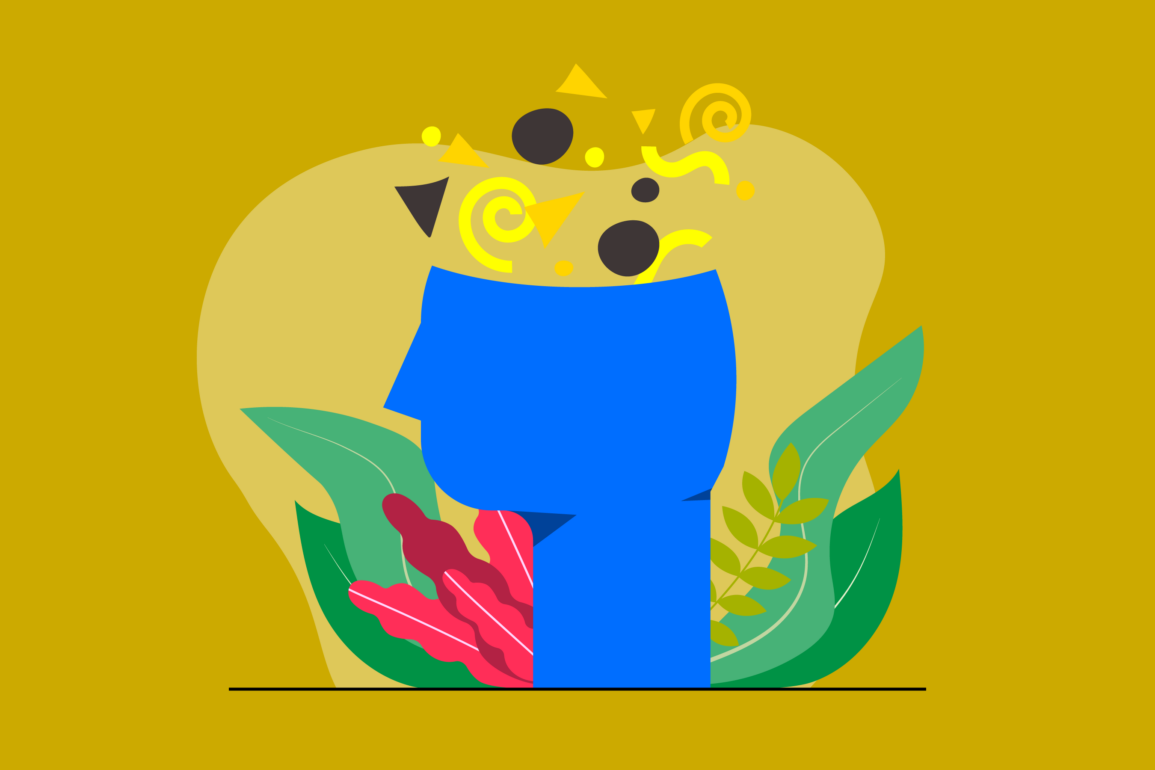What colors make blue? Your guide on how to make blue

What colors make blue? It’s a relatively common question for artists experimenting with their own custom color palettes. However, as you may have already learned, figuring out how to make blue can be much more complex than mixing shades like purple or green.
Mixing blue is difficult because the shade is already a primary and dominant color. In other words, it’s generally not created by combining different shades. You can use blue as a component of many other colors, such as purple, brown, and green.
However, when making your own blue swatches, you’ll likely spend more time blending blue shades than creating a true blue.
Of course, it’s still crucial for any artist or hobbyist to know how to create different shades of blue. After all, dark blue has a significantly different impact than light or baby blue.
Today, we’ll explore everything you need to know about making blue.
Blending blue: Can you make blue?
So, what colors make blue? It’s a difficult question to answer.
As one of the most popular colors in the world and an incredibly diverse hue, blue is one of the primary colors on any artist’s palette. It’s used to create depth and shadow and convey ideas of trustworthiness, serenity, and calm.
There are many different shades of blue for artists to choose from. Light blues are often best suited when painters want to create a tranquil atmosphere, while darker shades are robust and confident. Turquoise blues mix hints of green into the palette to generate a brighter outcome.
So, can you make a true blue from scratch? The simple answer is no. It’s challenging to create a true blue without having at least some form of blue shade available (such as Cyan). However, it is possible to learn what colors make Royal Blue, Powder Blue, Ice Blue, or virtually any other shade.
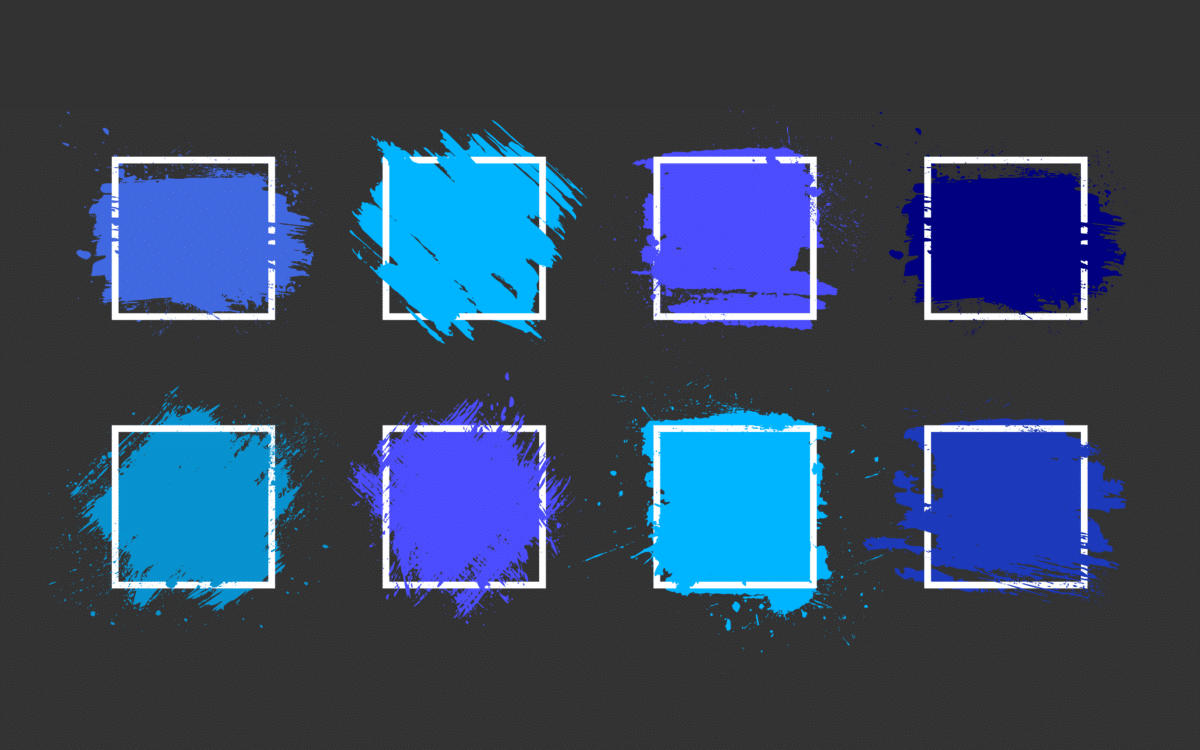
What colors make blue? How to get blue shades
There’s no honest answer to the question “What primary colors make blue?” because blue itself is a primary color. This means your focus as an artist or creative will be to create the right shade of blue. Fortunately, you’ll have a lot of freedom in this area.
As anyone who might have experimented with color palettes in the past will know, you can add various colors to different primary shades to give them extra weight, depth, or temperature. For instance, adding white to blue is a great way to create a light blue color.
Adding soft shades of grey can mute your blue while adding black, greens, reds, and purples darkens the hue.
Whenever you’re mixing blue, it’s crucial to have a gentle hand. The smallest amount of a new shade can completely transform the results. Adding just a hint of yellow to your blue paint will bring you closer to green, while a touch of red will push you into the purple territory.
For many professionals, blending the perfect blue shade will require a little trial and error. Remember, it’s always best to test blue swatches on fresh, white paper to see what they’ll look like outside the palette.
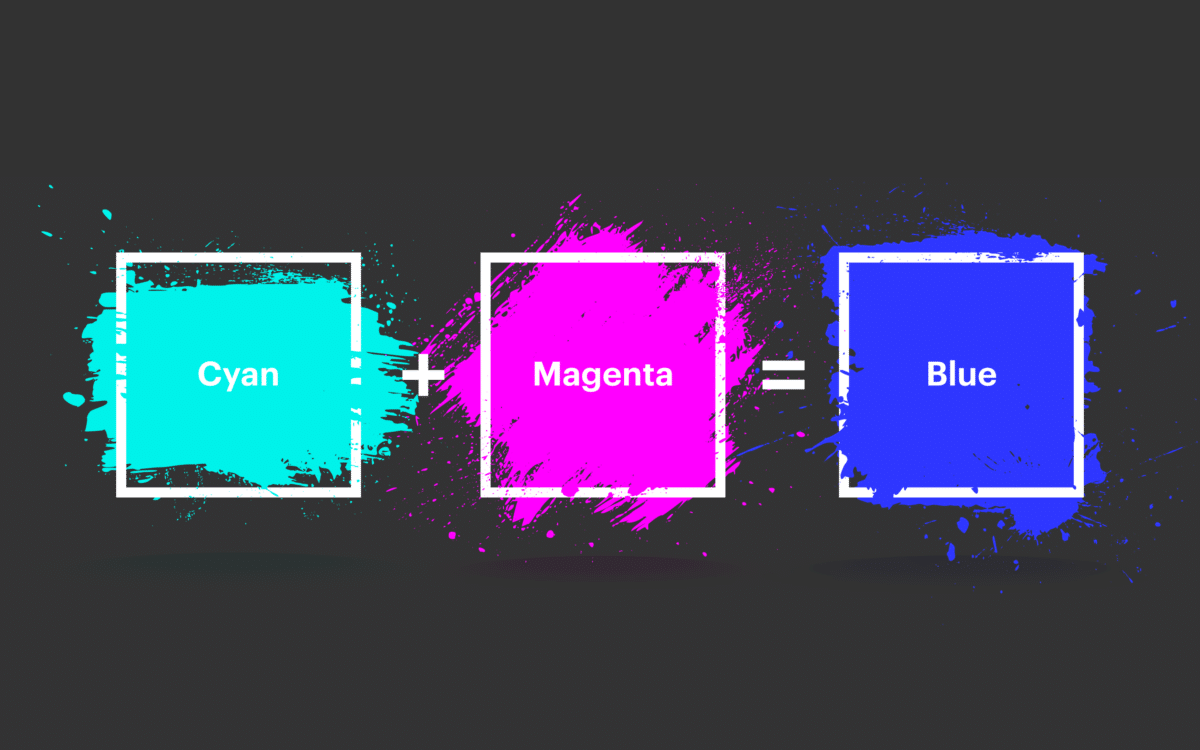
What two colors make blue?
So, what two colors make blue? First, mixing any existing shade of blue with white, grey, black, or green will create various shades of blue. However, before you can start designing your own tones, you’ll need to know how to make a primary “blue” shade.
The easiest option will always be to start with blue paint, ink, or a shade of blue in whatever medium you use. However, there are two colors you can mix to create a “true blue” from scratch. These are Cyan (a greenish blue used in the CYMK palette) and Magenta (purple-red).
Blending Cyan and Magenta is how modern CYMK printers make the blue most of us are familiar with today. However, you could argue that Cyan alone is already a kind of blue.
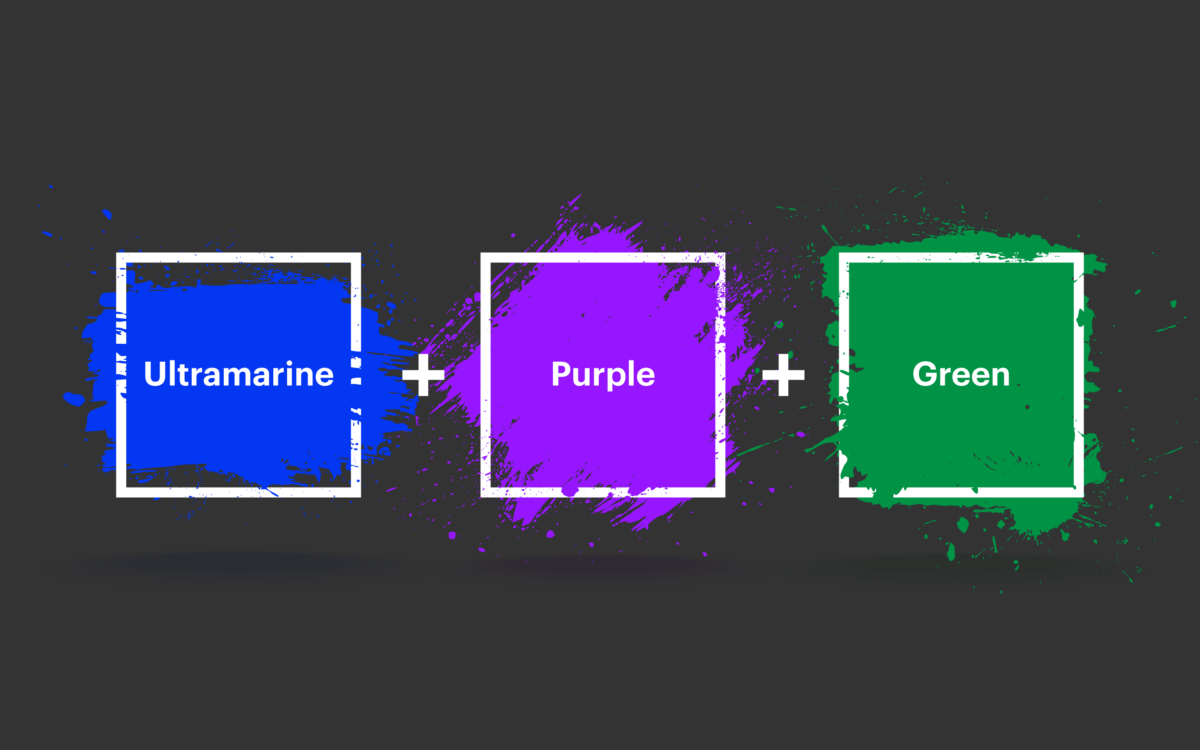
What three colors make blue?
Once you have your “true blue” shade from Cyan and Magenta, the options for creating more advanced hues are virtually limitless. When figuring out what colors make blue, you’ll likely need significant experimentation.
You can add specific shades of purple, orange, white, and green to blue to create a variety of attractive colors. Adding complementary colors to blue is a particularly effective way to mute the shade. Some of the three color combos you can use to make blue include:
- Royal Blue: Purple, black, and true blue
- Navy Blue: Black, orange, and true blue
- Turquoise: Blue, white, and green
- Deep blue: Ultramarine Blue, Dioxazine Purple, and Phthalo Green
- Warm blue: Ultramarine Blue, Phthalo Green, and Alizarin Crimson
- Grey blue: Cobalt Blue, white, and Cadmium Orange
One of the most effective ways to use three colors to make blue is to experiment with Turquoise shades. Blending a blue color with a green hue and adding a touch of white or black will allow you to create a multitude of greenish-blue results.
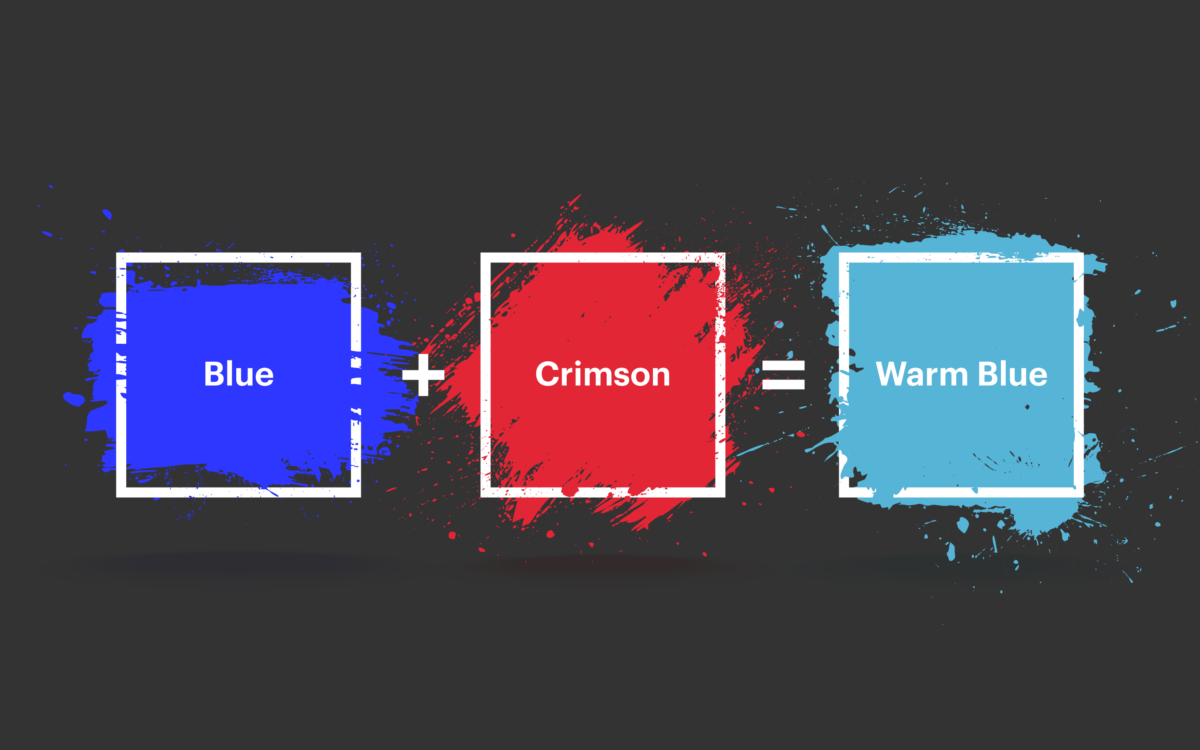
How to mix warm blue shades
Color temperature will always play an essential role in getting the perfect results from any project. Some shades are naturally warmer than others, while some are cooler.
You can use cold shades to make components of a piece seem more distant and relaxing, and warm colors make it bold and engaging. Ultimately, creating warm blue shades is difficult because blue is naturally cool.
The key to creating warm blue shades is ensuring you’re as gentle as possible with your palette. Adding too much of a particular shade can quickly turn your blue hue into a murky brown.
For the best results, start with a warmer style of blue, such as Ultramarine. Once you have your warm base, you’ll be able to start adding two colors for a warmer result: either Alizarine Crimson or Burnt Umber.
Alizarin Crimson is a deep red shade, which can quickly turn your blue purple if you’re not careful. Alternatively, Burnt Umber is a slightly yellowish-brown shade, which can cause your blue to seem a little murkier and muddier in some cases.
Burnt Sienna is another shade of red that you can experiment with. This is a deep shade of reddish brown, which adds significant depth and weight to an existing blue hue. Alternatively, consider using Cadmium Green to build a warm Turquoise shade.
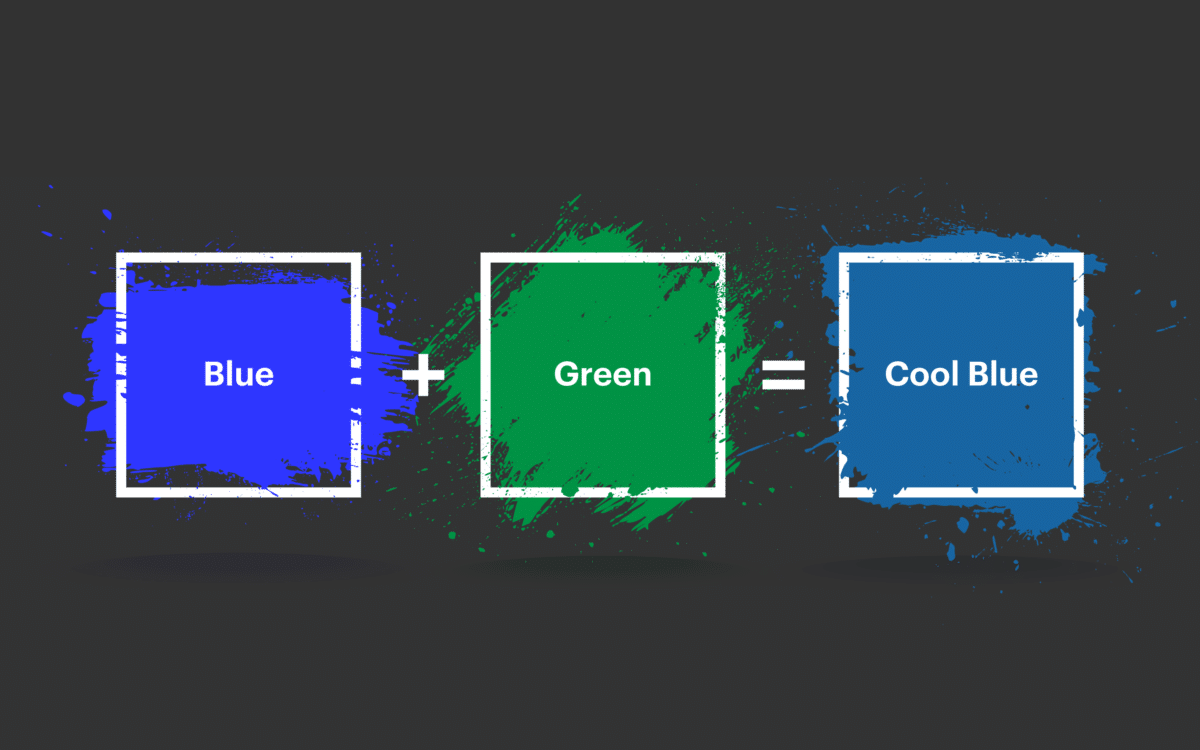
What colors make cool blue?
Designing your own shade of cool blue is much easier than creating a warmer blue because blue has a cool vibe as standard. An excellent way to make your standard blue even cooler is to add a splash of white, which further lightens the shade or a small amount of green.
Veronese and Cadmium Green are the most common green shades used to cool down blue hues. Veronese is a cool and bright green, ideal if you want your blue to be vibrant.
However, the foundation of blue you’re using can also influence the outcomes. Veronese and Ultramarine Blue mixed together create a cool, darker shade. Alternatively, Veronese and Cobalt Blue create something brighter and lighter.
Cadmium Green is a little warmer than Veronese Blue because it contains a tiny amount of red. This means adding it to your blue shade should produce a muted but cool shade of blue.
The red and blue mix of Ultramarine Blue and Cadmium Green will produce a finish that contains all three primary shades, which can create an earthier finish.
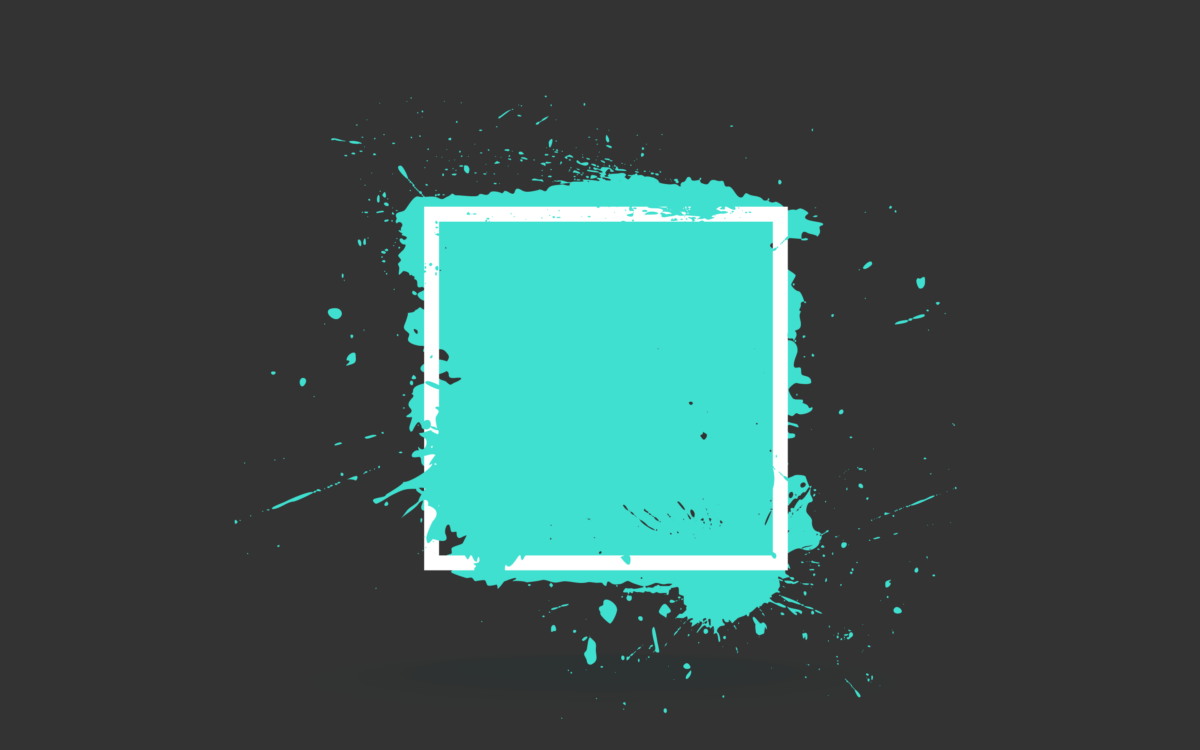
How to mix Turquoise blue colors
Turquoise is a typical shade for painting scenery, as it looks fantastic when depicting the sky, the sea, and other forms of water. Thanks to the yellow components in the green you’ll be mixing with your blue, the color will have a slight warmth.
The best way to mix Turquoise blue is to start with either an Ultramarine or Cobalt Blue shade. Ultramarine Blue will get you a darker, deeper color, even if you combine the result with extra white. Alternatively, because Cobalt Blue is brighter, it can create a much more vibrant finish.
When it comes to green options, you’ll still be using the Veronese or Cadmium Green hues we mentioned above, as these are great for maintaining the natural cool hue of your blues. Veronese Green is excellent for brighter, vibrant shades, while Cadmium Green is a little deeper.
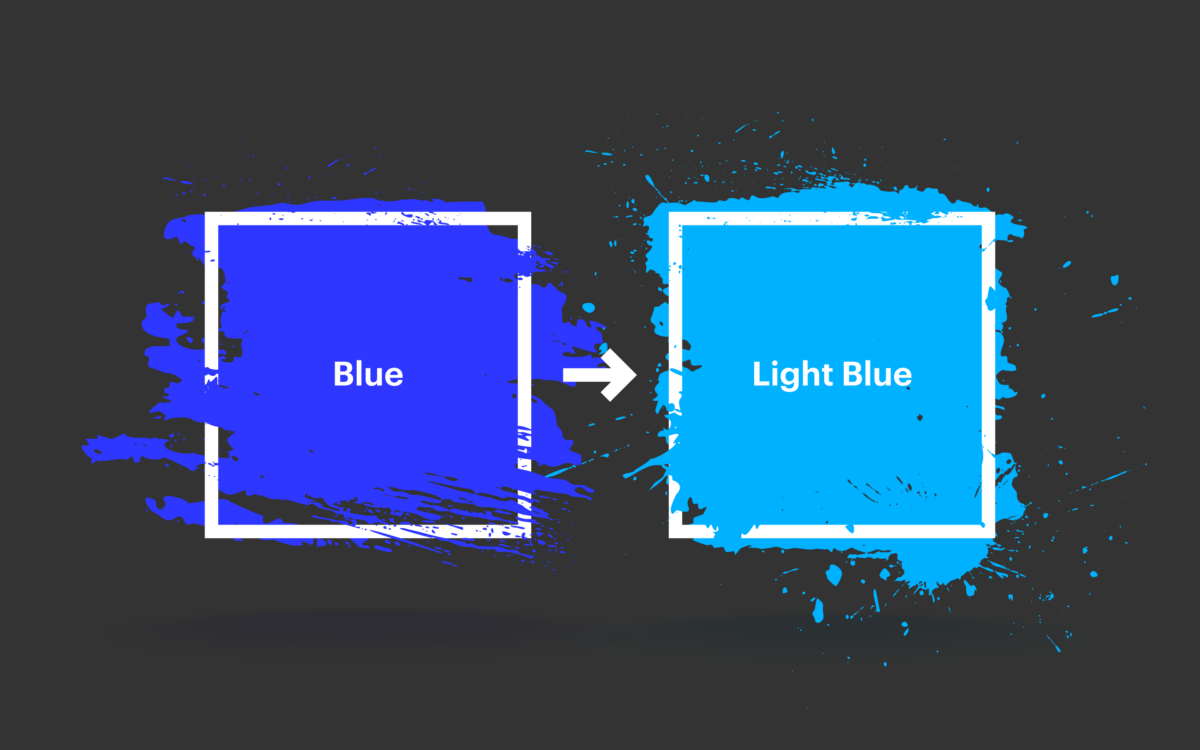
What colors make light blue?
If you’re looking to produce a light shade of blue, the easiest option is to add extra white to virtually any mixture. You can also consider an ashen shade of yellow if you want your resulting blue to be a light Turquoise shade.
The combination of Ultramarine Blue and white leads to a fantastic, vibrant shade of Cornflower Blue. You can also mix blue and a soft grey to get the same effect.
Alternatively, you could combine white and Royal Blue to get a powder blue color. If you’re wondering what colors make baby blue, you’ll need a bright shade of blue, such as Cobalt Blue, and a white shade.
You can also experiment with Ultramarine Blue, Cobalt Blue, and white all mixed together to make your own Baby Blue color.
Here are some options for creating the most common pale blue color palettes:
- Cornflower Blue: Grey and Cobalt
- Ice Blue color: Navy Blue and white
- Powder Blue: White and Royal Blue
- Light Turquoise: Royal Blue, white, and green
- Pale Blue: Powder Blue and white
- Cerulean: White and Cobalt Blue
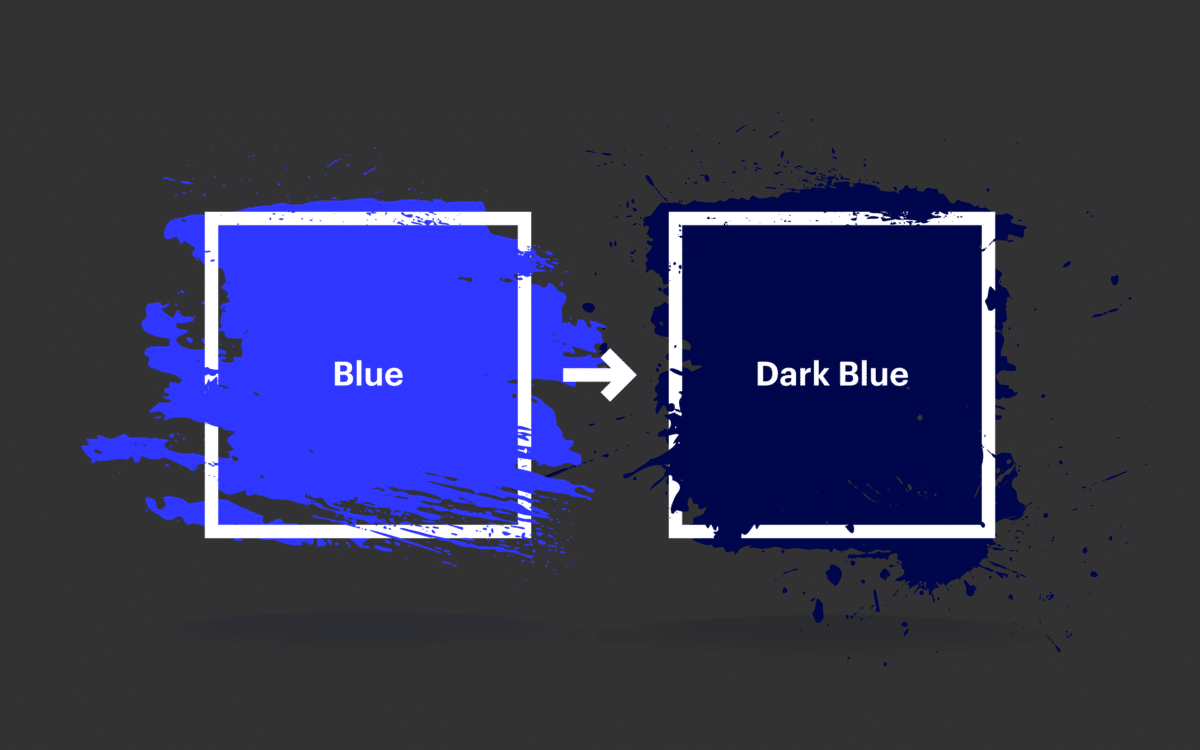
What colors make dark blue?
Like light blue, dark blue is relatively straightforward to create from scratch, provided you have a base blue shade to start with. Ultramarine Blue is already a fairly dark color, so it’s great when you want to design a more mysterious hue.
You can combine Turquoise and Ultramarine to make a Cobalt Blue color, or you can combine Ultramarine Blue and red to produce indigo.
When figuring out what colors make dark blue, it’s worth thinking about the color temperature you’re aiming for. Adding a shade like Dioxazine Purple to Ultramarine Blue will naturally create a warmer hue while maintaining a deep finish.
Alternatively, Phthalo Green and Ultramarine blue create a cooler shade, ideal for dark night skies and underwater images. Ultramarine Blue, Phthalo Green, and Alizarin Crimson also create a dark shade that edges into the territory of purple.
Burnt Umber is another good option for mixing dark blue shades if you’re keen to create a purple, earthy finish. Alternatively, you can create navy blue by mixing black, orange, and blue.
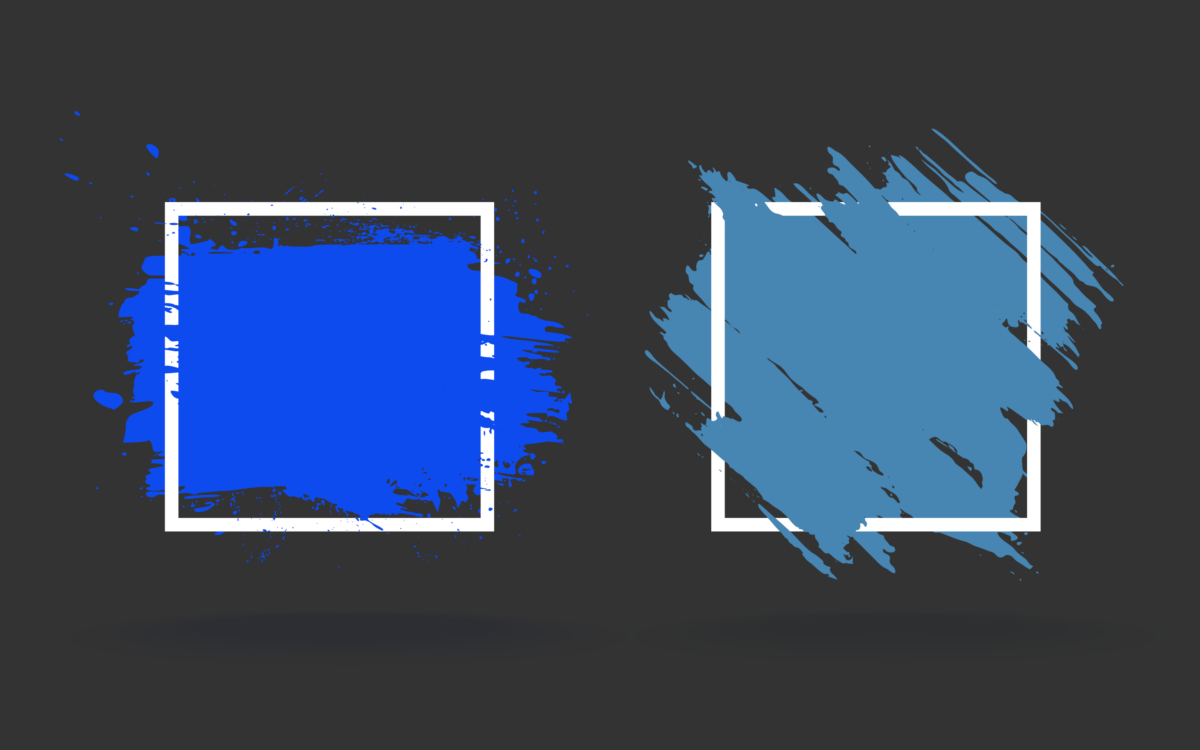
What colors make bright blue or muted blue?
Brighter blues are usually made using a combination of green, Cyan, white, and foundational blue shades. A small amount of light blue and green will create a Cyan shade, one of the initial colors commonly used when artists want to know what colors make blue.
Adding a couple of drops of yellow paint into your mixture will create a bright Turquoise blue shade. However, it’s important not to add too much white and yellow to a blue mix, as this can quickly lead to a green result.
When your project requires a more muted shade of blue, you can start with a brighter blue hue like Ultramarine or Cobalt. When mixed with white, these shades still maintain a lot of their brightness, so you can desaturate them slightly using slight amounts of orange.
Notably, in the color wheel, orange is the complementary color for blue. Adding complementary colors to a mix will often subdue both shades to create an earthier, muddier finish.
What colors do you mix to make blue?
Still struggling to fully understand what colors make blue?
Learning how to make blue can be particularly complex because it’s so easy to accidentally venture into the realm of other secondary colors if you add too much of a single shade. Here are some quick insights into how you can get started blending blue shades:
What colors make Royal Blue?
To make a Royal Blue color, start with a true blue shade mixing Cyan and Magenta, then add a small amount of purple. Purple will warm the color slightly and give you a dark Royal Blue shade. You can add a little white if you want to lighten and brighten the hue.
Alternatively, add a little black or grey if you want a much deeper shade of Royal Blue.
What colors make Cobalt Blue?
The easiest way to get an intense shade of Cobalt Blue is to mix a small amount of Turquoise with Ultramarine. You’ll need to start with a mixture of white, blue, and green to get your Turquoise, then add in the Ultramarine shade in small doses to get the proper depth.
You can lighten your Cobalt slightly with white, but be careful not to turn it back into Turquoise.
What colors make Aqua Blue?
To make an aqua blue shade, you’ll need a base of titanium white combined with a brilliant blue or Cobalt Blue.
Add the slightest amount of pale yellow to give the finish a slightly greenish tinge. Once again, you’ll need to be cautious about adding too much yellow here, as you can quickly make your aqua shade Turquoise, or green.
What colors make Navy Blue?
Navy Blue is actually a slightly muted version of a much brighter blue shade, like Cobalt Blue. Start with your Cobalt Blue, then add a small amount of orange into the mix to get a murkier but bold shade. This should create a fantastic navy color.
You can also experiment with small amounts of orange in Ultramarine Blue for a slightly different finish.
What colors make Teal Blue?
Teal is an excellent choice if you want a blue color that touches the green spectrum. All you need to do to make a Teal Blue is combine a small amount of green, such as Cadmium Green, with a base blue of Cobalt or Aquamarine.
You can also create a fantastic Teal by combining cerulean (a lighter shade of Cobalt) with a light green hue.
What colors do you mix to make blue?
Learning what colors make blue can be a little complex. Blue isn’t a secondary color but a primary shade, which means it’s not generally created by combining different hues. However, it is possible to create a true blue using Cyan and Magenta.
It’s also worth noting you can experiment with the various shades of blue available for your palette. Adding different shades to a foundation blue can produce various temperatures and hues to play with.
One example is adding green to blue. When you add green to blue, you get a fantastic Turquoise result. Alternatively, adding white to various shades of blue will give you a paler or lighter tone.
Implementing colors like purple, red, and deeper greens into your blues can produce dark and mysterious shades.
Alternatively, you can play around with orange to produce a muted shade of blue. Taking the time to experiment with all the different variations of blue you can make on your own is a great way to expand your color palette before any project.
Fabrik: A branding agency for our times.
Now read these:
—Exploring the colors of the rainbow





